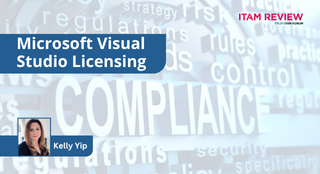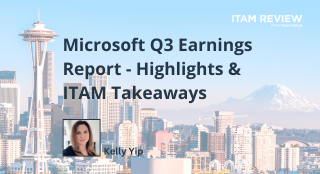Quick Guide to the Microsoft SAM Managed Service Program
You may already have heard talk about Microsoft introducing a SAM Managed Service – and, after attending the Microsoft Inspire partner conference, we’ve got more information for you here…both around the “how” and the “why”.
What is it?
Microsoft’s new SAM Managed Service Program introduces a new tier of Accredited Providers, partners “who offer a continual, governance-based, outsourced service” to help organisations manage their assets.
Microsoft’s aim is to take SAM beyond baselines and audits and to make it a positive, ongoing process that enables digital transformation among organisations.
We spoke with Patama Chantaruck, General Manager of Worldwide SAM and Compliance at Microsoft, and it was clear she was well aware of how SAM has been mis-represented in the past. She hopes this new programme will “reduce that misunderstanding” and that “It’s us (Microsoft), it’s the partner, we really need to catch up in helping our customers perform SAM in the right way”.
The SAM Managed Service Program has quite rigorous entry requirements and each partner will be certified by either EY (Ernst & Young) or PWC (PricewaterhouseCoopers) as an independent 3rd party, who will align processes to ISO standards. Microsoft are expecting only their top, crème de la crème partners to be able to attain this new standard.
Microsoft SAM Managed Service Program – How does it work?
Participating customers are required to share their Microsoft software deployment data with Microsoft regularly to be eligible for the program benefits. “This level of transparency enables Microsoft and the partner to help you maintain optimization of your technology investments, and assist in planning your dynamic technology roadmap.”
Through a series of ongoing SAM Optimisation Model (SOM) consultations, guidance sessions around End of Life technologies, a focus on patching, and annual reviews, this new Managed Service Program aims to make SAM an integral part of a customer’s IT processes and planning.
Microsoft are also looking to standardise results and interpretations of data across a wide range of tools.
“There are more than 100 SAM tools out there, so we’re working with the SAM tool partner and vendors to create what I call “Universal Inventory”. We work with participating tool vendors who want to participate to ensure a common base-quality level is established and data can flow from Inventory to Analysis environments safely and efficiently.”
 What changes are being made?
What changes are being made?
One of the changes being made as part of this SAM refocus is around compensation – Microsoft is no longer paying its SAM Partners for performing Baseline activities.
To be eligible for Microsoft compensation, they need to provide customers with one of Microsoft’s “value-focused” engagements, such as Server Optimisation. Similarly, Microsoft’s internal SAM reps are now paid on the overall success of the customer, rather than just on revenue from licensing shortfalls.” Changing how salespeople get paid can be a major factor in driving the required behaviour and, as altering the compensation plan is no easy feat at an organisation like Microsoft, it goes a long way to showing that Microsoft are serious about making this a success.
Another change is the alignment between the customer sales teams and the SAM teams. Historically, the SAM team would tend to be brought in when an EA was about to be lost or when “Zero Use” true ups were seen. The approach was often reactive, and focused more on just licenses, rather than adding overall value to the customer via SAM but as Patama said:
“Change that. No more. So, now the SAM team becomes part of the account planning.”
This will lead to SAM becoming a strategic, standard part of the approach taken by Microsoft sales teams when working with their customers – rather than something brought in once every “X” years.
While it’s perhaps hard not to be cynical and think “Here we go, they’re offering this, this time”, Patama clearly understands how important trust is between Microsoft and its customers.
“For me, (it’s about) trust. When you say you’re going to do (something) and (don’t) and you break (the trust), that’s it”
Industry Wide Focus
We spoke to Microsoft about the SAM Partner Competency and they were clear that it isn’t going to return. The main reason being that the competencies were inherently Microsoft focused, but that isn’t how they now view SAM. Microsoft recently launched a revised SAM MCP (Microsoft Certified Professional) exam and Patama said:
“To me, I think SAM is beyond just one company or one software vendor. When we created this MCP, we…wanted to make it industry standard”. The contents of the exam are “more on industry-wide SAM. Which, to me, it’s bigger than just Microsoft. We’re leading the way”
The vision is for the 70-713 MCP exam to be taken by people across the industry. Not necessarily because they’re a Microsoft partner but because they want an industry recognised certification based on standardized ISO SAM practices.
To be, or not to be
First, let us consider some of the reasons you may want to work with an accredited Microsoft SAM Managed Service provider.
Unique benefits
There are a range of benefits available to customers who take part in the program, including:
- The “Fresh Start” program regarding historical compliance
- A reduced* risk of Audit
- Technology roadmap discussions
- Cloud, Cyber Security, and/or other value-based consultations
- Review of end of life products
With more likely to be added over time from Microsoft, as well as partner specific extras.
*Microsoft cannot guarantee a participating customer will not be audited, but it is less likely. I think this helps show the clear distinction Microsoft are drawing between “SAM” and “audits”.
 Fresh Start
Fresh Start
This, for many, is perhaps the most intriguing element of the SAM Managed Service Program – whereby, once a licensing position is agreed, Microsoft will “will never look back”. That licensing position will be taken as compliant going forwards:

This will help keep the SAM engagements more focused around planning for the future and topics such as Cyber Security and Cloud readiness; rather than looking backwards at historical implementations.
Licensing Related Benefits
There are a range of licensing related benefits available to program participants, these include:
Down Edition Conversion* – ability to convert a license to the lower edition i.e. Professional Plus to Standard.
Strategic Cloud Replacement – allows an on-premises compliance gap to be filled with non-equivalent Cloud services
*One time only availability
Additionally, the ELP created via this program will be Microsoft’s view of the customer’s entitlement and becomes the “trustworthy snapshot” of what they own.
Thoroughbred partners
The process to become an accredited Microsoft SAM Managed Service Provider is no simple “answer a couple of questions and tick a box” process – there are several steps and costs involved, including a series of exams. Nor is it a guaranteed “pass these and you’re in” type arrangement – each partner is assessed against a range of standards (including ISO) by an independent 3rd party evaluator, currently either EY or PwC.
On top of that, the independent evaluator will perform an annual re-assessment on each partner to ensure standards of service are continually adhered to.
Access to resources
Customers taking part in the program may have greater access to Microsoft resources, things such as:
- Microsoft Technology Centre briefings
- Technology roadmap sessions
- CIO Summit invitations
I’ve seen on plenty of occasions that, for organisations pro-actively looking to embrace new technologies such as Office 365 and Azure, these additional resources from Microsoft can make a real difference internally. It can help secure the required business buy-in, get technical teams up to speed quicker and accelerate deployment. For many organisations, faster ROI, on top of an improved SAM position, would be a fantastic place to be.
That said, let’s look at the flip side – why might organisations be less keen to take part?
 Data sharing
Data sharing
One key element of this program is data sharing – allowing the partner, and thus Microsoft, a clear, ongoing view of your software install base. From the T&Cs:
“Customers must agree to share inventory/deployment data with Partner (and allow Partner to share the data with Microsoft) within ninety days of signing the agreement with Partner and every 6 months thereafter (at a minimum).”
This may put some organisations off, although with “Fresh Start” and Microsoft’s commitment to helping organisations improve SAM as an ongoing concern, I’m not sure this needs to be the red flag it perhaps once was.
Increased time overheads
Another key element of the Microsoft SAM Managed Service Program is a much closer, and more pro-active, relationship between customers, partners and Microsoft. This is going to mean update meetings, workshops, executive briefings, annual reviews and more. Done correctly, these can help drive the progress and value of SAM within a business, but some organisations may be unwilling, or unable, to commit to such a schedule.
 Perceived lack of control
Perceived lack of control
It also possible some organisations may worry that, with the closer relationship and focused workshops, they’ll be forced to move too quickly – particularly in terms of Cloud adoption and migrating off end of life products. However, while these are certainly a focus for Microsoft, one would anticipate that customer needs will be paramount and any upgrade/migration discussions will be recommendations, rather than decrees. Microsoft have made it clear that they will respect customers’ decisions regarding a move to the Cloud.
Conclusion
Speaking with the Microsoft UK & Worldwide SAM leads, I got the sense this is a real paradigm shift for Microsoft. They want SAM to permeate across the organisation and to become an integral, upfront part of customer discussions around Digital Transformation, Cloud Readiness, Cyber Security and more.
It’s not just a new exam, or a new incentive, it appears to be a whole new approach to Software Asset Management – for an industry vendor. We have seen many changes at Microsoft since Satya Nadella became CEO – today, more than 1 in 3 VMs in Azure run Linux; Microsoft has more than 15,000 contributors to GitHub; and the company brought SQL Server to Linux last year…I wonder if this new approach to SAM will be on that list in a couple of years’ time?
However, the proof of the pudding is in the eating and we must now look at how this is rolled out to partners and customers, how the benefits are delivered (and if they’re worthwhile), and if it truly does make for an easier, more valuable SAM model for all involved.
I’d love to hear your thoughts on this? Do you see it as a positive move? Do you have questions or concerns? Let me know!
Image credit
Image credit
Image credit
Image credit
Can’t find what you’re looking for?
More from ITAM News & Analysis
-
Broadcom vs Siemens AG - A Brewing Storm
The ongoing legal battle between VMware (under Broadcom ownership) and Siemens is yet another example of why ITAM goes far beyond license compliance and SAM. What might, at first glance, appear to be a licensing dispute, ... -
Shifting Left Together: Embedding ITAM into FinOps Culture
During one of the keynotes at the FinOps X conference in San Diego, JR Storment, Executive Director of the FinOps Foundation, interviewed a senior executive from Salesforce. They discussed the idea of combining the roles of ... -
Addressing the SaaS Data Gap in FinOps FOCUS 2.1
I recently reported on the FinOps Foundation’s inclusion of SaaS and Datacenter in its expanded Cloud+ scope. At that time, I highlighted concerns about getting the myriad SaaS companies to supply FOCUS-compliant billing data. A couple ...
Podcast
ITAM training
Similar Posts
-
Microsoft Visual Studio Licensing Guide: Reduce Risks
(This article was reviewed and updated on 3 July 2025) Visual Studio Licensing Visual Studio subscriptions are licensed Per User with each licensed user able to. “install and use the software on any number of device”. ... -
Broadcom vs Siemens AG - A Brewing Storm
The ongoing legal battle between VMware (under Broadcom ownership) and Siemens is yet another example of why ITAM goes far beyond license compliance and SAM. What might, at first glance, appear to be a licensing dispute, ... -
Microsoft Power Apps: Current Pricing Models Comparison
Back in November 2021, Microsoft made Power Apps available under the pay-as-you-go (PAYG) model, alongside the traditional Per User/Per App options. This PAYG model has gained popularity. It ensures simple rightsizing for Power Apps environments. Here, ... -
Microsoft Q3 Soars as AI and Azure Growth Fuels Market Gains
On the 30th April, Microsoft released its Q3 quarterly earnings report, exceeding expectations and igniting investor optimism. Investors had been keeping a watchful eye on Azure’s Cloud performance after Microsoft’s Q2 Cloud results fell short of ...




